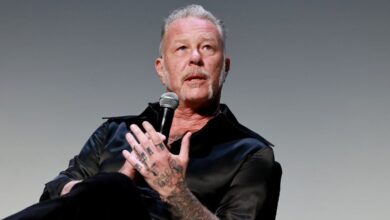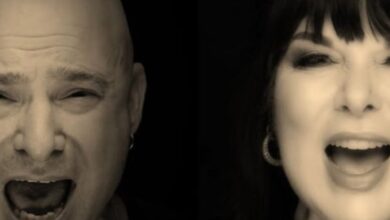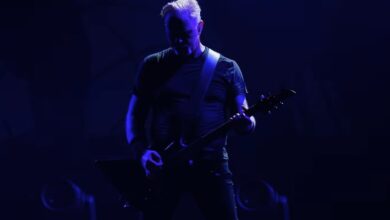Metallica Unleashed Raw Emotion with a Devastatingly Intense Performance of “One” in Melbourne 2025
Marvel Stadium was already buzzing before a single note of “One” rang out. On November 8, 2025, Melbourne finally got its night on the M72 World Tour, a long-awaited payback after the heartbreak of Metallica’s cancelled 2019 Australian dates. Tens of thousands poured into the venue, phones out, battle vests on, ready for a show that felt less like a gig and more like a historic correction. This wasn’t just another tour stop; it was the first proper stadium Metallica blowout in Melbourne in years, and everyone in the building seemed determined to make it count.
By the time the house lights finally dropped, Marvel Stadium was a sea of noise and nervous laughter. AC/DC’s “It’s a Long Way to the Top (If You Wanna Rock ’n’ Roll)” poured from the PA, a perfectly cheeky nod to local rock royalty. Then came Ennio Morricone’s “The Ecstasy of Gold,” the traditional Metallica pre-game hymn that somehow still raises goosebumps decades into their career. When the band strode out and smashed into “Creeping Death,” it felt like a bomb went off in the stadium. From that moment on, you could sense Melbourne was getting a full-throttle, no-shortcuts set.
The early part of the night was all about reminding everyone just how deep this band’s catalogue really runs. “For Whom the Bell Tolls” turned the floor into a single, lurching organism. “Fuel” arrived like a drag racer crashing through the front gates, with fire cannons to match. “The Memory Remains” had tens of thousands of Australians whistling and howling the Marianne Faithfull refrain into the cool night air. By the time “The Unforgiven” and “Wherever I May Roam” rolled through, people in the stands had fully surrendered—this wasn’t a warm-up; it was a main-event set from song three onward.
Somewhere in the middle of all that heaviness, the unspoken anticipation for “One” began to build. Old-school fans knew it was coming; newer fans were waiting to finally see the legendary war-torn epic they’d watched on screens for years. “One” isn’t just another track in a Metallica set—it’s a short film, a sensory assault, and an emotional punch to the chest crammed into nine minutes. Born on 1988’s …And Justice for All, its anti-war story and brutal climax have turned it into a ritual centerpiece of almost every major Metallica show, and Melbourne was clearly not going to be an exception.
The transition into that moment was almost cinematic. After the more expansive, atmospheric weight of “The Day That Never Comes,” the stage lighting cooled into eerie blues and harsh whites. The big circular screens switched to grainy, war-like imagery, smoky silhouettes of soldiers and explosions flickering in fragmented bursts. You could feel a hush sweep across the stadium—tens of thousands of people collectively realizing, “Okay, this is it.” Snare drums cracked like distant gunshots, and those familiar, unsettling sound effects started crawling across the PA. The entire production quietly rearranged itself around the impending arrival of “One,” like the show itself was holding its breath.
When James Hetfield finally stepped to the mic and the clean guitar arpeggios of the intro floated out over Marvel Stadium, the whole place seemed to shrink. Despite the size of the venue, it suddenly felt intimate. Phone flashlights went up in pockets and then spread until the stands looked like a slow-moving galaxy. Hetfield’s vocal delivery on the opening verses had that weathered, lived-in tone he’s developed in recent years—less youthful snarl, more worn storyteller—making the lyrics land with a different kind of gravity. People swayed, some quietly singing along, others just staring at the screens, completely locked in.
Kirk Hammett’s clean guitar lines danced delicately around James’ rhythm part, and for a moment you could almost forget there were tens of thousands of people around you. Then the first real sonic punch arrived. The band dropped into the heavier section with a synchronized hit that felt physically jolting, Lars Ulrich’s kick drums slamming through the concrete. Strobes began firing in jagged bursts, mimicking gunfire, while rapid-cut war visuals flashed on the screens—soldiers, explosions, smoke, silhouettes running through chaos. It was the classic “One” staging, but amplified by the scale of Marvel Stadium and the war-themed visuals and pyro that turned a song into a battlefield.
What made this performance feel especially powerful was Hetfield himself. Between songs earlier in the night, he’d talked about how grateful the band was to finally be back in Australia after the cancelled 2019 run, openly acknowledging his rehab and the band’s struggles in that period. Now, standing in the middle of this massive stadium, his voice cracked just slightly in the song’s most fragile moments—enough to make “I cannot live, I cannot die” sound less like a line from an old video and more like something pulled from his own scars. You could tell Melbourne understood the subtext, and the cheers between sections had an extra layer of warmth in them.
Hammett took center stage when the solo section hit, and the crowd roared like a jet engine. His wah-drenched tone sliced through the mix, every bend and flurry of notes magnified on the giant screens overhead. This wasn’t a sterile, surgically precise solo; it had that slightly ragged, live-wire energy that reminds you there’s a human at the other end of the guitar. When he nailed the long, sustained notes near the climax, the stadium erupted, sections of the crowd punching the air like they were celebrating a last-minute goal in a grand final. For many, this was the moment they’d been waiting years to see in person.
Meanwhile, Rob Trujillo and Lars Ulrich did what they do best: they turned the entire foundation of the song into a blunt-force weapon. Trujillo’s bass rumbled underfoot, making the floor vibrate during the chugging mid-section, while Lars locked into that unmistakable machine-gun rhythm that defines the end of “One.” High up in the stands, people could hear every snare hit echoing off the stadium roof, turning the finale into something almost militaristic. When the band hit those final, staccato accents in perfect unison, the entire place seemed to jerk in time with them, as if 50,000 bodies were being yanked by the same invisible string.
The crowd energy around “One” was its own story. Down on the floor, pits that had gone wild for fast tracks like “Creeping Death” and “Fuel” transformed into dense clusters of bodies standing almost unnervingly still for the early verses, then exploded into movement as the song accelerated. In the seats, older fans who’d grown up with …And Justice for All were standing beside teenagers in fresh tour shirts, both generations headbanging in perfect sync when the heavy section kicked in. It was one of those rare live moments where age, background, and how long you’d been a fan just stopped mattering.
Part of what makes “One” hit so hard, especially in 2025, is that its themes refuse to get old. The story of a soldier trapped in his own body, unable to speak or escape, has only grown more unsettling as the world cycles through new conflicts and new headlines. In Melbourne, you could sense that people weren’t just reacting to the spectacle, but to the story underneath it. Some fans watched the screens with folded arms and furrowed brows; others closed their eyes and just let the song wash over them. It felt less like a metal anthem and more like a stadium-sized moment of reflection disguised as a rock song.
The performance gained even more emotional weight when you considered what Hetfield had done earlier in the day. Before the show, he visited a new mural honoring late bassist Cliff Burton, as well as the Bon Scott tribute in AC/DC Lane, paying quiet respects to two giants of heavy music history. Those images had already circulated online by the time the band hit the stage, and when “One” unfolded—this harrowing song about loss, pain, and the cost of war—it was impossible not to connect it to the sense of legacy and remembrance that surrounded their Melbourne visit.
“One” also sat in a setlist that was cleverly tuned to Australian rock DNA. Earlier in the night, Kirk and Rob’s “doodle” section turned into a loving nod to local heroes, with bits of The Living End’s “Prisoner of Society” and a taste of INXS’s “Don’t Change” slipping into the mix. It was the kind of move that instantly wins over a home crowd and reminded everyone that Metallica doesn’t just bulldoze into a city—they pay attention to where they’re standing. With those tributes still ringing in people’s ears, “One” arrived not just as a Metallica classic but as part of a broader conversation between American metal and Australian rock history.
After “One” finally crashed to its brutal halt, there was a split second of stunned silence before Marvel Stadium detonated. People screamed, hugged, and high-fived complete strangers. Some fans looked genuinely dazed, like they’d just been through something physically exhausting. And yet, the night was far from over. “Nothing Else Matters” brought a communal sing-along big enough to shake the rafters, “Master of Puppets” turned the floor into a riotous wave of bodies, and “Enter Sandman” closed things out like a city-wide victory lap. But ask anyone filing out into the Melbourne night which song they’ll be replaying in their heads tomorrow, and a huge chunk of them would name “One” without hesitation.
By the time fans reached the train platforms and tram stops, clips of “One” from Marvel Stadium were already hitting YouTube, Instagram, and group chats. Grainy phone footage couldn’t capture the full force of the pyro or the feeling of the sub-bass rattling your chest, but it was enough to confirm what everyone who was there already knew: they had just witnessed a special version of a song that’s already legendary. In a touring cycle packed with massive moments, “One” in Melbourne stood out as the point where spectacle, emotion, history, and gratitude all converged—and for a few blazing minutes, a stadium became the center of the Metallica universe.





